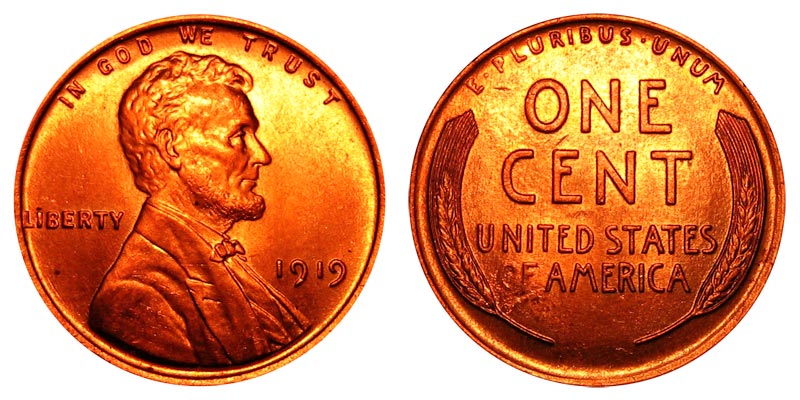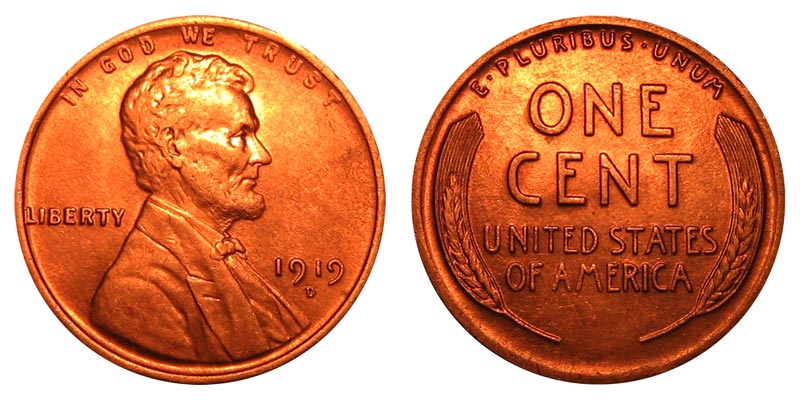1919 Lincoln Wheat Penny Value
Depending on the mint mark, the 1919 Lincoln Wheat cent is worth between $2 and $10 in most circulated grades. Mint state examples can trade from $30 to $100 and higher, especially if the coin comes from one of the branch mints in Denver and San Francisco.

1919 Lincoln Wheat cent. Image:USA CoinBook
1919 Wheat Penny Price Chart by Grade
1919 Wheat Penny Value
The 1919 Lincoln Wheat penny is highly sought-after by collectors, especially pennies that are in mint condition. To appraise a coin, several key areas must be evaluated. Factors like mint population, condition, coloration, imperfections, and production errors take importance in determining the sale value of a 1919 Wheat penny.
The value of a 1919 penny is determined by three main factors: the mintage population, mint mark, and condition of the coin.
Mint populations are found using the small letter, or mint mark, found beneath the date on the penny to determine which mint it came from. For example, a small “S” underneath the year represents San Francisco for the mint location. (Coins struck in Philadelphia bear no mint mark.) The mint location indicates how many of the coins were made to determine their level of scarcity.

1919-S Lincoln Wheat cent. Image: USA CoinBook
In 1919, the Philadelphia Mint issued the highest number of cents. Wheat pennies from Philadelphia are the most common. San Francisco pennies are second availability and command a higher value. Denver is the most rare and expensive in terms of mint population. Compared to Philidelphia, finding coins minted in San Francisco and Denver can be challenging, and thus they are considerably more expensive. As a result, Philadelphia coins are considered to be abundant in terms of their rarity.
In terms of coloration, the Wheat penny series varies in value based on whether the metal appears brown, brown/red, or red. Brown is considered the most common and least valuable, whereas red is the least common and the most valuable. Brown pennies tend to lack their original mint luster, and red pennies are usually bright and lustrous.
Imperfections on a coin such as nicks, scratches, dents, excessive wear, bent edges, and more can downgrade the value of the coin. For example, if the physical condition of the coin appears worn, eroded, or scratched by natural causes outside of production, then the price would be lower.
However, production errors that occurred at the mint are much less common and therefore deemed extremely valuable. Manufacturing errors can range from double lettering to misaligned strikes to melted edges due to machinery mistakes. You can read more about Lincoln penny errors by following the link.
The value of the penny depends on the mint mark and preservation level. Oftentimes, coins that have survived over a century tend to remain in circulation and are typically low value. Taking all of these factors into consideration is key to navigating from a sale viewpoint.
1919 Wheat Penny History
The Lincoln Wheat cent series was first introduced in 1909 and remained in circulation until 1958. In 1909, President Theodore Roosevelt wanted to mint a coin with Lincoln's profile. The penny displayed Lincoln’s profile on the obverse to honor the President's 100th birthday. Before then, American cents—indeed, all American coins—had never depicted a real person before.

1919-D Lincoln Wheat cent. Image: USA CoinBook
Despite initial opposition from traditionalists, the design was executed by Victor David Brenner, an engraver and sculptor. His design was originally criticized for placing his initials "VDB" on the coins. The US Mint changed this and had them removed. However, the initials were restored a few years later in 1918 and can be found on coins minted in 1919.
The reverse design was revamped during the Presidential term of President Dwight D. Eisenhower. It added the Lincoln Memorial building in honor of the 150th anniversary of Lincoln's birth.
What Are the Features of the 1919 Penny?
The 1919 Lincoln penny features the 16th American president. On this coin, he is prominently positioned on the obverse, with his bust facing towards the right and the date "1919" below to the right. The top rim of the coin is inscribed with the phrase, “IN GOD WE TRUST,” while the inscription “LIBERTY” can be seen to the left of the president's bust. The design is uncluttered and includes a small letter “S” or “D” below the date to indicate coins minted in San Francisco or Denver, respectively. The designer's initials, "VDB," can be found hidden along the bust's shoulder.
The reverse side contains the words “ONE CENT” and “UNITED STATES OF AMERICA” surrounded by two wheat stalks. (Hence the name Wheat penny, sometimes nicknamed "wheat backs" or "wheaties.") Eventually, in 1958, these inscriptions were replaced with an engraving of the Lincoln Memorial. Listed below are some of the physical properties of the penny.
1919 Lincoln Wheat Cent Specifications
Composition: 95% Copper (Cu), 5% Tin (Sn) and Zinc (Zn)
Coin Diameter: 0.75 inch (19 millimeters)
Face Value = 1 Cent ($0.01)
Weight: 0.10970 ounce (3.11 grams)
Thickness: 0.05984 inch (1.52 millimeters)
Written by Daniel Sandoval
Read more about how much different coins are worth from the numismatic experts at Gainesville Coins:
2009 Lincoln Penny Value and Designs: Bicentennial Cents
Simple List of 6 Rare State Quarters Worth Money
No Date Buffalo Nickels: How to Find Their Value
1921 Morgan and Peace Silver Dollar Values (Price Charts)
10 Most Valuable Canadian Coins & What They're Worth
Guide to Numismatics: Discover the Thrill of Coin Collecting
